Hotpoint H6TGC1E, H6TGCF, H6GG1E Manual

Operating Instructions
COOKER
|
|
|
|
|
|
|
|
|
|
|
|
|
Contents |
|
|
|
|
|
|
|
GB |
||
|
|
|
|
|
|
|
|
|
|
|
|
|
Installation, 2 |
|
|
|
GB |
|
FR |
|
|
|
|
|
|
|
Positioning and levelling |
||||
|
|
|
|
|
Electrical connection |
||
|
|
|
|
|
|||
English,1 |
Français, 13 |
Gas connection |
|||||
|
|
|
|
|
Adapting to different types of gas |
||
|
|
|
|
|
Technical data |
||
|
|
|
|
|
Table of burner and nozzle specifications |
||
H6TGC1E FR H6TGCF FR H6GG1E FR
Description of the appliance, 7
Overall view Control panel
Start-up and use, 8
Using the hob
Using the oven
Oven cooking advice table
Precautions and tips, 11
General safety Disposal
Respecting and conserving the environment
Care and maintenance, 12
Switching the appliance off Cleaning the appliance Replacing the oven light bulb Gas tap maintenance
The catalytic self-cleaning system Assistance
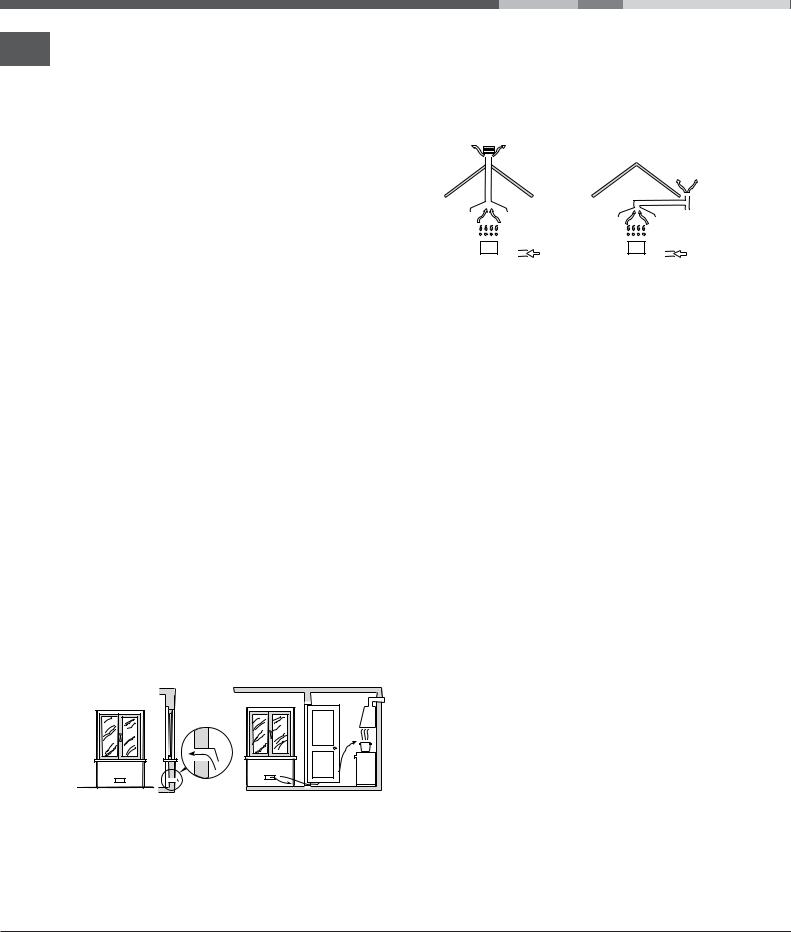
Installation
! Before operating your new appliance please read GB this instruction booklet carefully. It contains
important information concerning the safe installation and operation of the appliance.
!Please keep these operating instructions for future reference. Make sure that the instructions are kept with the appliance if it is sold, given away or moved.
!The appliance must be installed by a qualified professional according to the instructions provided.
!Any necessary adjustment or maintenance must be performed after the cooker has been disconnected from the electricity supply.
Room ventilation
The appliance may only be installed in permanentlyventilated rooms, according to current national legislation. The room in which the appliance is installed must be ventilated adequately so as to provide as much air as is needed by the normal gas combustion process (the flow of air must not be lower than 2 m3/h per kW of installed power).
The air inlets, protected by grilles, should have a duct with an inner cross section of at least 100 cm2 and should be positioned so that they are not liable to even partial obstruction (see figure A).
These inlets should be enlarged by 100% - with a minimum of 200 cm2 - whenever the surface of the hob is not equipped with a flame failure safety device. When the flow of air is provided in an indirect manner from adjacent rooms (see figure B), provided that these are not communal parts of a building, areas with increased fire hazards or bedrooms, the inlets should be fitted with a ventilation duct leading outside as described above.
Adjacent room |
Room requiring |
|
ventilation |
A B
A |
|
|
Ventilation opening |
Increase in the gap |
|
for comburent air |
between the door and |
|
the flooring |
||
|
! After prolonged use of the appliance, it is advisable to open a window or increase the speed of any fans used.
Disposing of combustion fumes
The disposal of combustion fumes should be guaranteed using a hood connected to a safe and efficient natural suction chimney, or using an electric fan that begins to operate automatically every time the appliance is switched on (see figure).
|
|
|
|
|
|
|
|
|
|
|
|
|
|
|
|
|
|
|
|
|
|
|
|
|
|
|
|
|
|
|
|
|
|
|
|
|
|
|
|
|
|
|
|
|
|
|
|
|
|
|
|
|
|
|
|
|
|
|
|
|
|
|
|
|
|
|
|
|
|
|
|
|
|
|
|
|
|
|
|
|
|
|
|
|
|
|
|
|
|
|
|
|
|
|
|
|
|
|
|
|
|
|
|
|
|
|
|
|
|
|
|
Fumes channelled |
Fumes channelled through |
||||||||||||
straight outside |
a chimney or a branched |
||||||||||||
|
|
|
|
|
|
|
|
flue system (reserved for |
|||||
|
|
|
|
|
|
|
|
cooking appliances) |
|||||
! The liquefied petroleum gases are heavier than air and collect by the floor, therefore all rooms containing LPG cylinders must have openings leading outside so that any leaked gas can escape easily.
LPG cylinders, therefore, whether partially or completely full, must not be installed or stored in rooms or storage areas that are below ground level (cellars, etc.). Only the cylinder being used should be stored in the room; this should also be kept well away from sources of heat (ovens, chimneys, stoves) that may cause the temperature of the cylinder to rise above 50°C.
Positioning and levelling
!It is possible to install the appliance alongside cupboards whose height does not exceed that of the hob surface.
!Make sure that the wall in contact with the back of the appliance is made from a non-flammable, heatresistant material (T 90°C).
To install the appliance correctly:
•Place it in the kitchen, dining room or the bed-sit (not in the bathroom).
•If the top of the hob is higher than the cupboards, the appliance must be installed at least 600 mm away from them.
•If the cooker is installed underneath a wall cabinet, there must be a minimum distance of 420 mm between this cabinet and the top of the hob.
This distance should be increased to 700 mm if the wall cabinets are flammable (see figure).
2
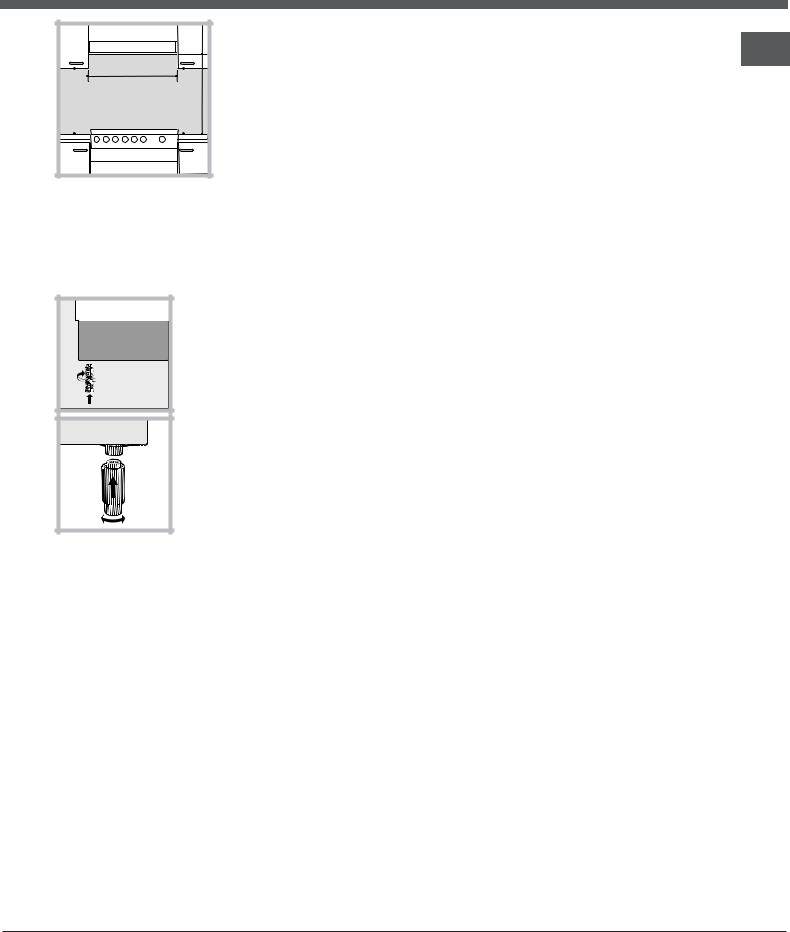
HOOD
|
Min. 600mm. |
min. 650 mm. with hood min. 700 mm. without hood |
Min. 420mm. |
Min. 420mm. |
•Do not position blinds behind the cooker or less than 200 mm away from its sides.
•Any hoods must be installed according to the instructions listed in the relevant operating manual.
Levelling
If it is necessary to level the appliance, screw the adjustable feet into the places provided on each corner of the base of the cooker (see figure).
The legs* fit into the slots on the underside of the base of the cooker.
Electrical connection
Install a standardised plug corresponding to the load indicated on the appliance data plate (see Technical data table).
The appliance must be directly connected to the mains using an omnipolar circuit-breaker with a minimum contact opening of 3 mm installed between the appliance and the mains. The circuit-breaker must be suitable for the charge indicated and must comply with current national legislation (the earthing wire must not be interrupted by the circuit-breaker). The supply cable must be positioned so that it does not come into contact with temperatures higher than 50°C at any point.
Before connecting the appliance to the power supply, make sure that:
•The appliance is earthed and the plug is compliant with the law.
•The socket can withstand the maximum power of the appliance, which is indicated by the data plate.
* Only available in certain models
• The voltage is in the range between the values |
GB |
|
indicated on the data plate. |
||
|
•The socket is compatible with the plug of the appliance. If the socket is incompatible with the plug, ask an authorised technician to replace it. Do not use extension cords or multiple sockets.
!Once the appliance has been installed, the power supply cable and the electrical socket must be easily accessible.
!The cable must not be bent or compressed.
!The cable must be checked regularly and replaced by authorised technicians only.
!The manufacturer declines any liability should these safety measures not be observed.
Gas connection
Connection to the gas network or to the gas cylinder may be carried out using a flexible rubber or steel hose, in accordance with current national legislation and after making sure that the appliance is suited to the type of gas with which it will be supplied (see the rating sticker on the cover: if this is not the case see below). When using liquid gas from a cylinder, install a pressure regulator which complies with current national regulations. To make connection easier, the gas supply may be turned sideways*: reverse the position of the hose holder with that of the cap and replace the gasket that is supplied with the appliance.
! Check that the pressure of the gas supply is consistent with the values indicated in the Table of burner and nozzle specifications (see below). This will ensure the safe operation and durability of your appliance while maintaining efficient energy consumption.
Gas connection using a flexible rubber hose
Make sure that the hose complies with current national legislation. The internal diameter of the hose must measure: 8 mm for liquid gas supply; 13 mm for methane gas supply.
Once the connection has been performed, make sure that the hose:
•Does not come into contact with any parts that reach temperatures of over 50°C.
•Is not subject to any pulling or twisting forces and that it is not kinked or bent.
•Does not come into contact with blades, sharp corners or moving parts and that it is not compressed.
3
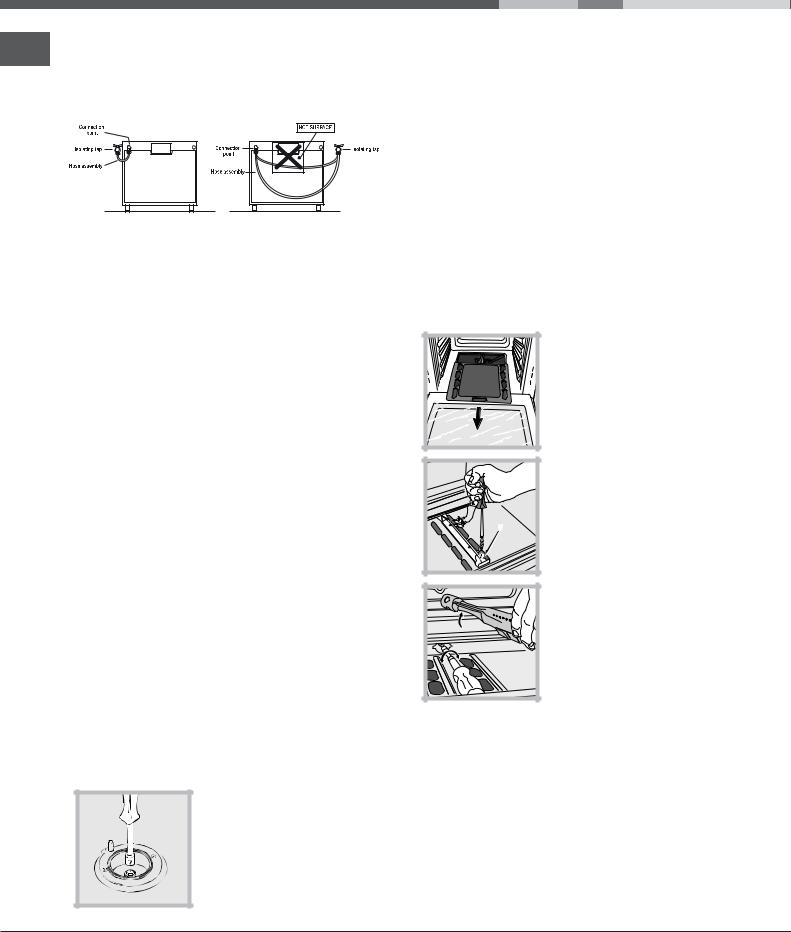
•Is easy to inspect along its whole length so that GB its condition may be checked.
•Is shorter than 1500 mm.
•Fits firmly into place at both ends, where it will be
fixed using clamps that comply with current regulations.
! If one or more of these conditions is not fulfilled or if the cooker must be installed according to the conditions listed for class 2 - subclass 1 appliances (installed between two cupboards), the flexible steel hose must be used instead (see below).
Connecting a flexible jointless stainless steel pipe to a threaded attachment
Make sure that the hose and gaskets comply with current national legislation.
To begin using the hose, remove the hose holder on the appliance (the gas supply inlet on the appliance is a cylindrical threaded 1/2 gas male attachment).
! Perform the connection in such a way that the hose length does not exceed a maximum of 2 metres, making sure that the hose is not compressed and does not come into contact with moving parts.
Checking the tightness of the connection
When the installation process is complete, check the hose fittings for leaks using a soapy solution. Never use a flame.
Adapting to different types of gas
It is possible to adapt the appliance to a type of gas other than the default type (this is indicated on the rating label on the cover).
Adapting the hob
Replacing the nozzles for the hob burners:
1. Remove the hob grids and slide the burners off their seats.
Adjusting the hob burners’ minimum setting:
1.Turn the tap to the minimum position.
2.Remove the knob and adjust the regulatory screw, which is positioned inside or next to the tap pin, until the flame is small but steady.
!If the appliance is connected to a liquid gas supply, the regulatory screw must be fastened as tightly as possible.
3. While the burner is alight, quickly change the position of the knob from minimum to maximum and vice versa several times, checking that the flame is not extinguished.
!The hob burners do not require primary air adjustment.
Adapting the oven
Replacing the oven burner nozzle: 1. Open the oven door fully
2. Pull out the sliding oven bottom (see diagram).
V |
3. Remove the oven burner after unscrewing the screws V (see figure).
4. Unscrew the nozzle using a special nozzle socket spanner (see figure) or with a 7 mm socket spanner, and replace it with a new nozzle that is suited to the new type of gas (see Burner and nozzle specifications table).
Adjusting the gas oven burner’s minimum setting:
1.Light the burner (see Start-up and Use).
2.Turn the knob to the minimum position (MIN) after it has been in the maximum position (MAX) for approximately 10 minutes.
3.Remove the knob.
4.Tighten or loosen the adjustment screws on the outside of the thermostat pin (see figure) until the flame is small but steady.
4
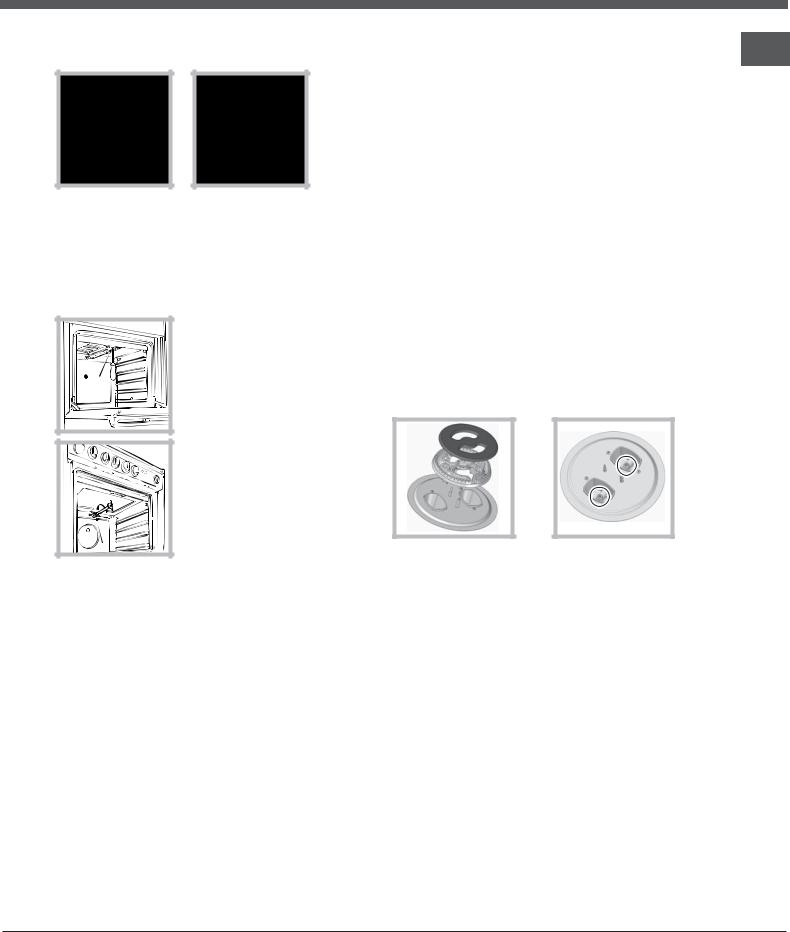
! In the case of natural gas, the adjustment screw must be unscrewed by turning it anti-clockwise.
5. Turn the knob from the MAX position to the MIN position quickly or open and shut the oven door, making sure that the burner is not extinguished.
Adapting the grill
Replacing the grill burner nozzle:
1. Remove the oven burner after loosening screw V (see figure).
 V
V
Replacing the Triple ring burner nozzles*
GB
1. Remove the pan supports and lift the burners out of their housing. The burner consists of two separate parts (see pictures).
2. Unscrew the nozzles using a 7 mm socket spanner. Replace the nozzles with models that are configured for use with the new type of gas (see Table 1). The two nozzles have the same hole diameter.
3. Replace all the components by completing the above operations in reverse order.
• Adjusting the burners’ primary air :
Does not require adjusting.
• Setting the burners to minimum:
1.Turn the tap to the low flame position.
2.Remove the knob and adjust the adjustment screw, which
is positioned in or next to the tap pin, until the flame is small but steady.
3.Having adjusted the flame to the required low setting, while the burner is alight, quickly change the position of the knob from minimum to maximum and vice versa several times, checking that the flame does not go out.
I |
2. Unscrew the grill burner nozzle using a special nozzle socket spanner (see figure) or preferably with a 7 mm socket spanner, and replace it with a new nozzle that is suited to the new type of gas (see Burner and nozzle specifications table).
!Be careful of the spark plug wires and the thermocouple tubes.
!The oven and grill burners do not require primary air adjustment.
!After adjusting the appliance so it may be used with a different type of gas, replace the old rating label with a new one that corresponds to the new type of gas (these labels are available from Authorised Technical Assistance Centres).
!Should the gas pressure used be different (or vary slightly) from the recommended pressure, a suitable pressure regulator must be fitted to the inlet hose in accordance with current national regulations relating to “regulators for channelled gas”.
* Only available in certain models
4.Some appliances have a safety device (thermocouple) fitted. If the device fails to work when the burners are set to the low flame setting, increase this low flame setting using the adjusting screw.
5.Once the adjustment has been made, replace the seals on the by-passes using sealing wax
!If the appliance is connected to liquid gas, the regulation screw must be fastened as tightly as possible.
!Once this procedure is finished, replace the old rating sticker with one indicating the new type of gas used. Stickers are available from any of our Service Centres.
!Should the gas pressure used be different (or vary slightly) from the recommended pressure, a suitable pressure regulator must be fitted to the inlet pipe (in order to comply with current national regulations).
5
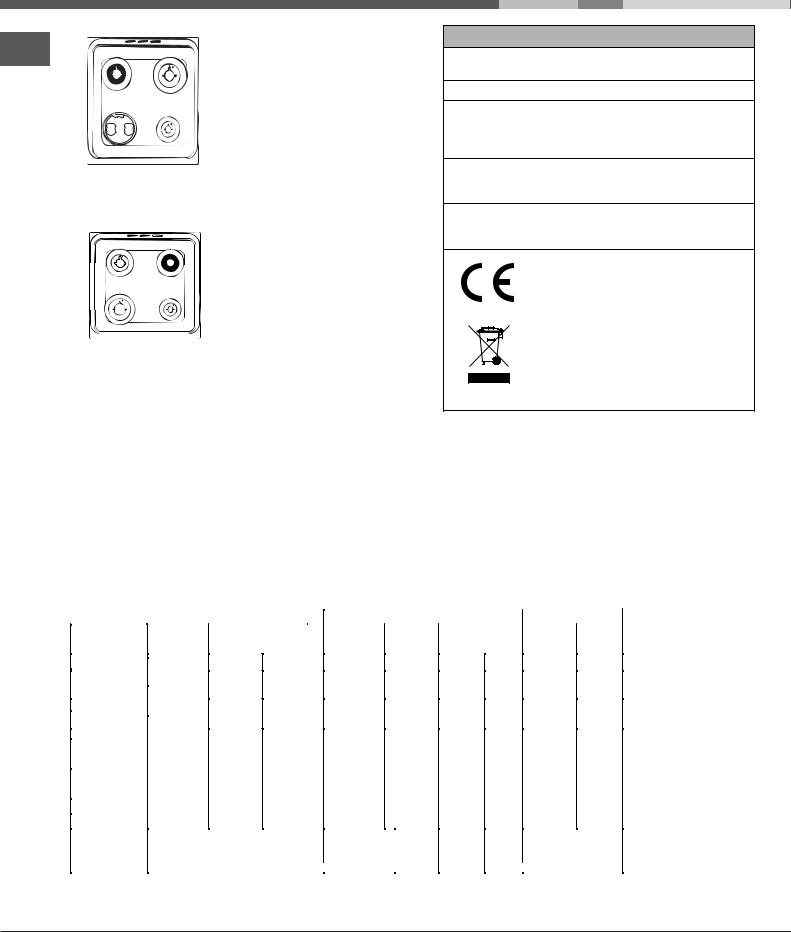
GB
 S R
S R

 TC A
TC A
H6TGC1E FR
H6TGCF FR
S S 
R A
H6GG1E FR
Table of burner and nozzle specifications
TECHNICAL DATA |
|
|
Oven Dimensions |
31x43,5x43,5 cm |
|
HxWxD |
||
|
||
Volume |
58 l |
|
Useful |
width 46 cm |
|
measurements |
||
depth 42 cm |
||
relating to the |
||
height 8,5 cm |
||
oven compartment |
||
|
||
Voltage and |
see data plate |
|
frequency |
||
|
||
Burners |
may be adapted for use with any |
|
type of gas shown on the data |
||
|
plate. |
|
|
EC Directives 2006/95/EC dated |
|
|
12/12/06 (Low Voltage) and |
|
|
subsequent amendments - |
|
|
04/108/EC dated 15/12/04 |
|
|
(Electromagnetic Compatibility) |
|
|
and subsequent amendments - |
|
|
90/396/EEC dated 29/06/90 (Gas) |
|
|
and subsequent amendments - |
|
|
90/68/EEC dated 22/07/93 and |
|
|
subsequent amendments. - |
|
|
2002/96/EC. |
|
|
1275/2008(Stand-by/Off-mode) |
Table 1 |
|
|
|
|
|
Liquid Gas |
|
Natural Gas |
|||
Burner |
Diameter |
Thermal Power |
By Pass |
Nozzle |
Flow* |
|
Nozzle |
Flow* |
|||
|
(mm) |
kW (p.c.s.*) |
1/100 |
1/100 |
g/h |
|
1/100 |
l/h |
|||
|
|
Nominal |
Reduced |
(mm) |
(mm) |
*** |
|
** |
(mm) |
|
|
Tripple ring |
130 |
|
3.25 |
|
1.50 |
63 |
2x65 |
236 |
232 |
2x99 |
|
309 |
(TC) |
|
|
|
|||||||||
|
|
|
|
|
|
|
|
|
|
|
|
|
|
|
|
|
|
|
|
|
|
|
|
|
|
Fast |
100 |
|
3.00 |
|
0.7 |
41 |
87 |
218 |
214 |
128 |
|
286 |
|
|
|
||||||||||
(Large)(R) |
|
|
|
|||||||||
|
|
|
|
|
|
|
|
|
|
|
|
|
Semi Fast |
75 |
|
1.90 |
|
0.4 |
30 |
69 |
138 |
136 |
104 |
|
181 |
(Medium)(S) |
|
|
|
|||||||||
|
|
|
|
|
|
|
|
|
|
|
|
|
Auxiliary |
51 |
|
1.00 |
|
0.4 |
30 |
50 |
73 |
71 |
78 |
|
95 |
(Small)(A) |
|
|
|
|||||||||
|
|
|
|
|
|
|
|
|
|
|
|
|
Oven |
- |
|
2.60 |
|
1.0 |
52 |
78 |
189 |
186 |
119 |
|
189 |
|
|
|
2.30 |
|
- |
- |
75 |
167 |
164 |
114 |
|
219 |
|
|
Nominal (mbar) |
|
|
|
28-30 |
37 |
|
20 |
|||
|
|
Minimum (mbar) |
|
|
|
20 |
25 |
|
17 |
|||
|
|
Maximum (mbar) |
|
|
|
35 |
45 |
|
25 |
|||
|
mbar-dry gas |
*** |
Butane P.C.S. = 49,47 MJ/Kg |
|
|
|
||||||
|
. = 50,37 MJ/Kg |
|
Natural P.C.S. = 37,78 MJ/m³ |
|
|
|
||||||
6
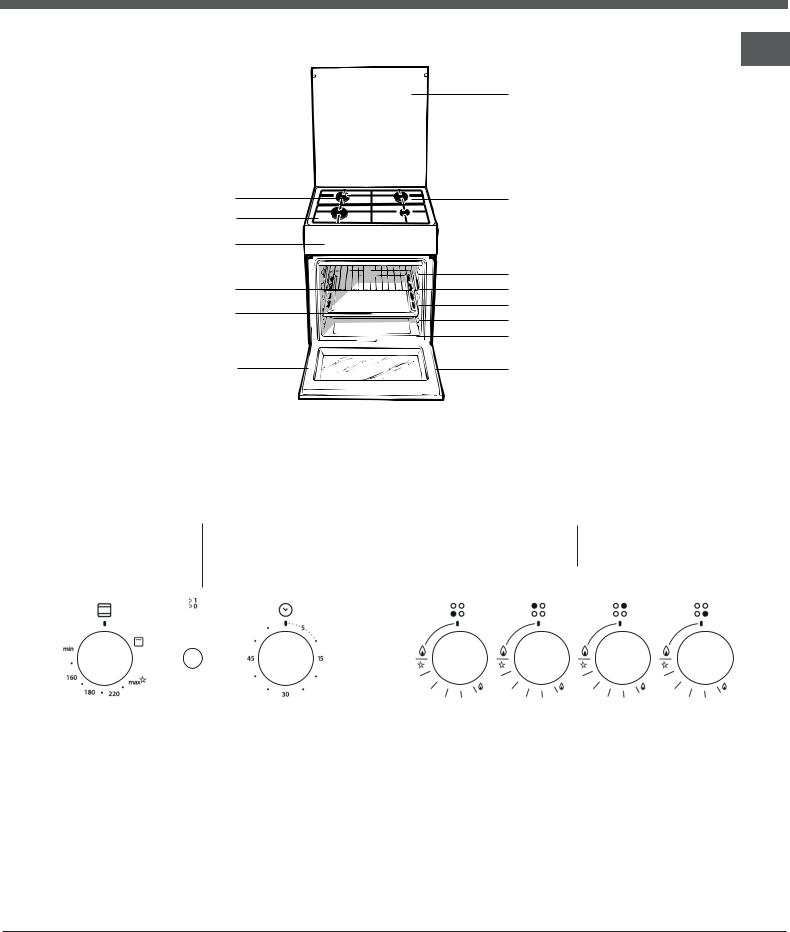
Description of the appliance
Overall view
GB
Glass cover*
Gas burner |
Containment |
|
Hob grid |
surface for spills |
|
Control panel |
GUIDE RAILS |
|
|
for the sliding racks |
|
|
position 5 |
|
GRILL rack |
position 4 |
|
DRIPPING PAN |
position 3 |
|
position 2 |
||
|
||
|
position 1 |
|
Adjustable foot |
Adjustable foot |
|
|
Control panel
OVEN LIGHT and |
Hob BURNER |
ROTISSERIE*button |
control knobs |
|
|
|
|
|
|
|
|
|
|
|
|
|
|
|
|
|
|
|
|
|
|
|
|
|
|
|
|
|
OVEN |
TIMER |
||||
|
control knob |
knob* |
||||
* Only available in certain models.
7
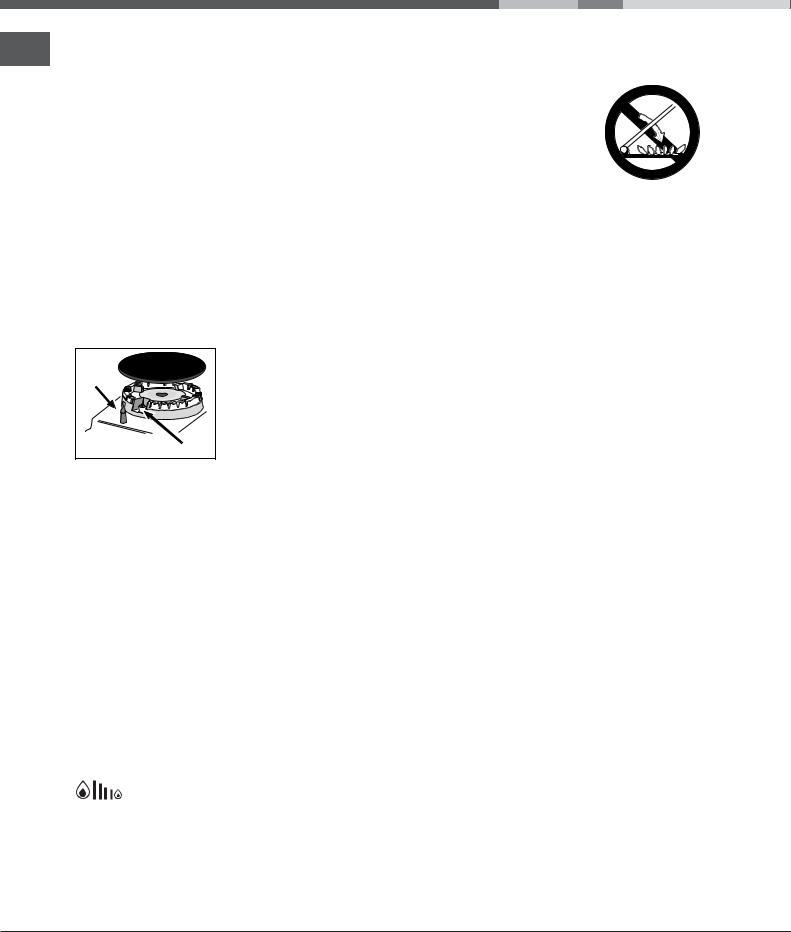
Start-up and use
! Before operating the product, remove all plastic
GB |
film from the sides of the appliance. |
|
|
|
Using the hob |
|
Lighting the burners |
For each BURNER knob there is a complete ring showing the strength of the flame for the relevant burner.
To light one of the burners on the hob:
1.Bring a flame or gas lighter close to the burner.
2.Press the BURNER knob and turn it in an anticlockwise direction so that it is pointing to the maximum flame setting E.
3.Adjust the intensity of the flame to the desired level by turning the BURNER knob in an anticlockwise direction. This may be the minimum setting C, the maximum setting E or any position in
between the two.
X |
C |
If the appliance is fitted with an electronic lighting device* (see figure; C), press the BURNER knob and turn it in an anticlockwise direction, towards the minimum flame setting, until the burner is lit. The burner
may be extinguished when the knob is released. If this occurs, repeat the operation, holding the knob down for a longer period of time.
!Since the hob burners are equipped with a safety device (X), you must hold the control knob in for about 3-7 seconds after the burner has been lighted to allow the gas to pass until the safety thermocouple has heated.
!If the flame is accidentally extinguished, switch off the burner and wait for at least 1 minute before attempting to relight it.
Flame adjustment according to levels
the burner flame intensity can be adjusted with the knob according to 6 power levels, from maximum to minimum with 4 intermediate positions:
a click will indicate the change from one level to another when turning the knob. The system guarantees a more precise adjustment, allows to replicate the flame intensity and to identify easily the preferred level for different cooking operations.
To switch the burner off, turn the knob until it reaches the stop position •.
WARNING! The glass lid can break in if it is heated up. Turn off all the burners and the electric plates before closing the lid.*
Practical advice on using the burners
For the burners to work in the most efficient way possible and to save on the amount of gas consumed, it is recommended that only pans that have a lid and a flat base are used. They should also be suited to the size of the burner.
|
|
|
|
|
|
|
|
|
|
|
|
|
|
|
|
To identify the type of burner, please refer to the diagrams contained in the “Burner and nozzle specifications”.
! On the models supplied with a reducer shelf, remember that this should be used only for the auxiliary burner when you use casserole dishes with a diameter under 12 cm.
Using the oven
!The first time you use your appliance, heat the empty oven with its door closed at its maximum temperature for at least half an hour. Ensure that the room is well ventilated before switching the oven off and opening the oven door. The appliance may emit a slightly unpleasant odour caused by protective substances used during the manufacturing process burning away.
!Never put objects directly on the bottom of the oven; this will avoid the enamel coating being damaged. Only use position 1 in the oven when cooking with the rotisserie spit.
*. Only available in certain models
8
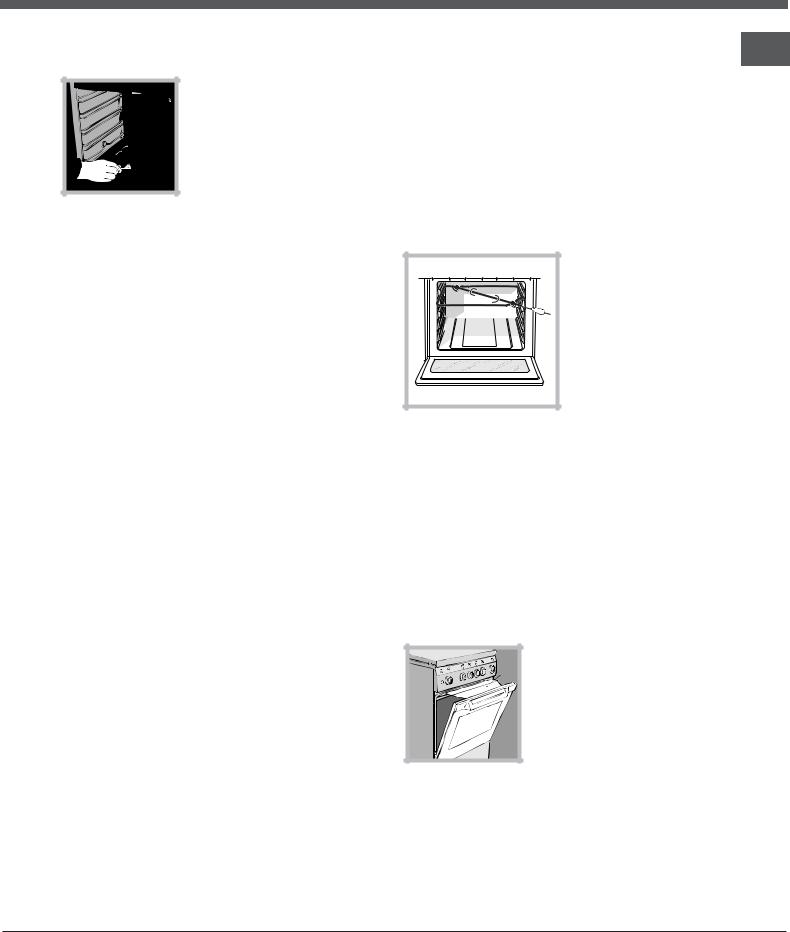
Lighting the oven
To light the oven burner, bring a flame or gas lighter close to opening F (see figure) and press the OVEN control knob while turning it in an anticlockwise direction until it reaches the MAX position.
If the appliance is fitted with an electronic lighting device* (see figure), press the OVEN knob and turn it in an anticlockwise direction, towards the MAX position, until the burner is lit. If, after 15 seconds, the burner is still not alight, release the knob, open the oven door and wait for at least 1 minute before trying to light it again. If there is no electricity the burner may be lit using a flame or a lighter, as described above.
! The oven is fitted with a safety device and it is therefore necessary to hold the OVEN control knob down for approximately 6 seconds.
! If the flame is accidentally extinguished, switch off the burner and wait for at least 1 minute before attempting to relight the oven.
Adjusting the temperature
To set the desired cooking temperature, turn the OVEN control knob in an anticlockwise direction. Temperatures are displayed on the control panel and may vary between MIN (150°C) and MAX (250°C). Once the set temperature has been reached, the oven will keep it constant by using its thermostat.
Grill
To light the grill, bring a flame or gas lighter close to the burner and press the OVEN control knob while turning it in a clockwise direction until it reaches the d position. If the appliance is fitted with an electronic lighting device* (see figure), press the OVEN knob and turn it in an clockwise direction, towards the d position, until the burner is lit. The grill enables the surface of food to be browned evenly and is particularly suitable for roast dishes, schnitzel and sausages. Place the rack in position 4 or 5 and the dripping pan in position 1 to collect fat and prevent the formation of smoke.
* Only available in certain models.
! The grill is fitted with a safety device and it is
therefore necessary to hold the OVEN control knob GB down for approximately 6 seconds.
! If the flame is accidentally extinguished, switch off the burner and wait for at least 1 minute before attempting to relight the grill.
Turnspit*
To operate the rotisserie (see diagram) proceed as follows:
1. Place the dripping pan in position 1.
2. Place the rotisserie support in position 4 and insert the spit in the hole provided on the back panel of the oven.
3. Acitvate the function by pressing the TURNSPIT button.
Oven light
The light may be switched on at any moment by pressing the OVEN LIGHT button.
Timer*
To activate the Timer proceed as follows:
1.Turn the TIMER knob in a clockwise direction 4 for almost one complete revolution to set the buzzer.
2.Turn the TIMER knob in an anticlockwise direction 5 to set the desired length of time.
D |
! When using the grill, leave the oven door ajar, positioning
the deflector D between the door and the control panel (see figure) in order to prevent the knobs from overheating.
9
